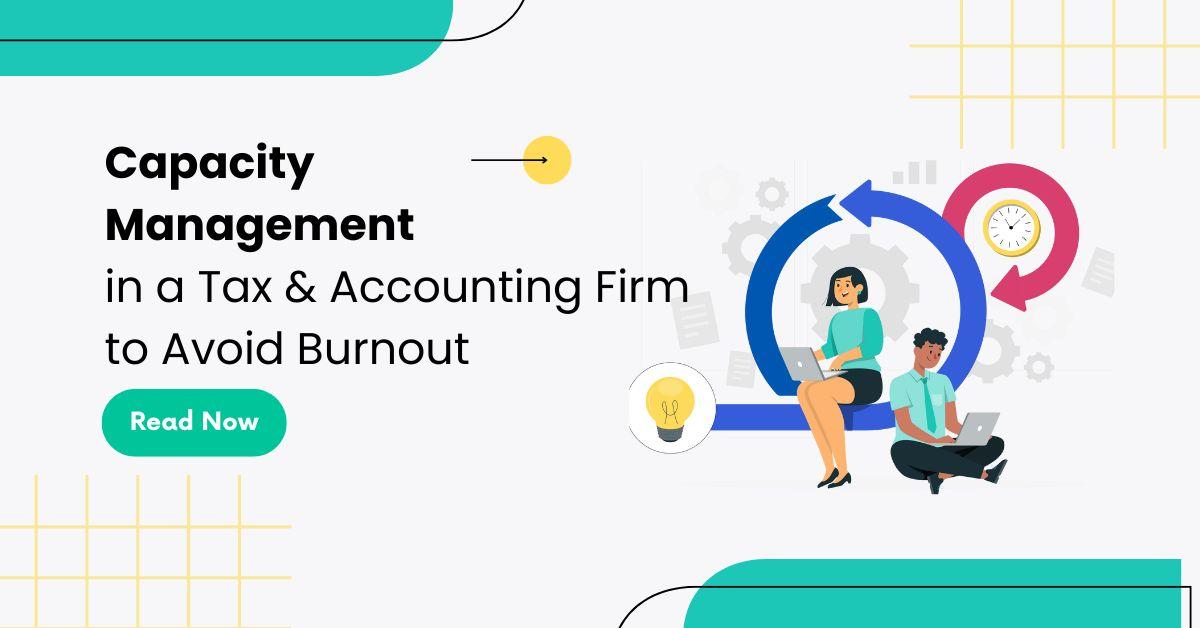
9 Practical Ways Accounting AI Is Being Used by Modern Firms
You’ll see exactly what “Accounting AI” looks like in practice. We’ve structured it as a simple list of the 9 smartest ways firms like yours can use AI in accounting.

Burnout is becoming synonymous with the accounting industry. Why? People blame the pipeline issue, but I say, poor capacity management is the real culprit.
Planning capacity in a tax and accounting firm involves managing resources, time, and client expectations to ensure smooth operations, especially during peak seasons like tax time.
In this guide, you’ll learn:
Becky and her team were running at about 200% capacity per person in tax season. Becky managed the books of clients and also helped with Tax prep. She started picking clients at low prices to grow her work and get it off the ground. But, it became difficult to deliver results with limited staff.
It’s a situation where the workload feels like a tidal wave, relentless and overwhelming.
The result?
Significant burnout, with mental and physical health taking a serious hit.
To turn things around, Becky implemented a series of strategic moves that not only saved her team from leaving the firm but also set the stage for a more sustainable, balanced approach to managing capacity in her tax firm.
Here’s a glimpse of what she did:
But she didn’t stop there—she also focused on elevating others within her firm. There was a clear imbalance in the task-to-capacity ratio. She needed new hires, but they were hard to find in this competitive job market. She decided to hire tax preparer offshore and solve capacity issues in her tax firm.
This shift not only lightened her load but also distributed the workload more evenly across the team.
3. Redefining Workload and Priorities: Becky then took a hard look at how work was being allocated. She redefined team roles and prioritized to ensure that no one was stretched too thin.
The goal was clear: make sure the workload was balanced and manageable for everyone.
Becky contacted Credfino before the Tax season 2023 and now her firm is running super smoothly.
Had a similar experience around capacity management like Becky and looking for partner to turn things around? Let’s talk!
I was fortunate to help Becky with capacity management and solve the biggest problem for her.
But, the biggest problem with Tax season was the sudden influx of work.
This was a solution that empowered Becky to stop her clients from running the firm and take charge herself.
Becky began following a system—calendar approach for capacity planning that transformed how her firm operated.
Want to know more about that? Read till the end
Becky’s story about capacity management and growing her tax firm doesn’t end here.
This year she decreased the number of clients and increased revenue.
How did she do that? Read here.
Back to the capacity management system. Having this system is non-negotiable for tax firms. Curious about what this system entails?
That’s exactly what we’re going to dive into next.
What we are going to discuss now might sound overwhelming because this is not something you can get done in a day.
Following the capacity management system, firms can not only handle peak seasons more efficiently but also enhance overall client satisfaction and team well-being.
Start by putting your clients in order. Not all clients are created equal, and that’s okay. The key is to recognize their value, the complexity of their needs, and the type of services they require.
1.1 Tiering Clients: Establish a ranking system to prioritize your clients. Think of it like this:
1.2 Service Packages: Offer tiered service packages that clearly outline what each client can expect.
A three-tiered pricing model is a straightforward business strategy that presents your customers with three distinct service options, each at a different price point. This approach works whether you’re using fixed pricing, value pricing, or volume pricing.
Ryan Lazanis promotes this strategy in his Future Firm Accelerator group. Also, you can see three-tiered pricing model on the Future Firm website.
For instance:
The Pro package might include a mid-year and end-of-year meeting, giving clients the peace of mind that you’re on top of their needs throughout the year.
The Elite package could take it a step further, adding extra advisory services and faster response times, ensuring your top clients always feel like they’re getting VIP treatment.
By categorizing and tailoring your approach, you can get rid of scope creep. By outlining the scope of work in every package, you make sure you get paid for additional work. If a client asks for more service, you can simply ask them to upgrade the plan which will give you the opportunity to plan capacity.
2. Integrate Smart Technology
AI and Automation: Make your life easier with AI tools that handle routine tasks, freeing up your time for more important work. Tools like Financial Cents can be game-changers, offering resource management and capacity tracking features that keep everything running smoothly.
Automate Billing and Payments: Say goodbye to manual invoicing and chasing payments. Use tools like Pluto to automate your accounts receivable and payable processes, ensuring timely collections and cutting down on the need for follow-ups.
3. Set Clear Expectations and Guidelines
Client Onboarding: Kick things off right with an onboarding meeting for new clients. This is your chance to review guidelines, set clear expectations, and make sure everyone is on the same page from the start.
4. Always Have a Backup Plan
Emergency Preparedness: Life happens, so plan for it. Identify an offshore accounting partner or a trusted colleague who can step in when things get hectic.
Cross-Training: Make sure your team is versatile. Cross-training ensures that someone can always pick up the slack if a team member is unavailable.
5. Reflect and Improve Continuously
Post-Mortem Analysis: After each month or major project, gather your team for a debrief. Discuss what went well, what didn’t, and brainstorm ways to improve next time.
Document Challenges: Keep track of any issues as they arise. This documentation will be invaluable for refining processes in future projects.
6. Structure Your Firm Around Tasks
Scalability: Implement a task-driven approach where every task is clearly documented and assigned. This structure not only keeps things organized but also makes it easier to scale as your client base grows.
Accountability: Hold each team member accountable for their tasks, with regular performance reviews to ensure everyone is meeting expectations.
7. Plan for Payroll
Anticipate Delays: Be proactive by setting internal deadlines ahead of actual ones. If payroll must be submitted by Tuesday, require all client information by Monday morning to avoid last-minute scrambles.
Enforce Late Fees: Encourage timely submissions by implementing late payroll fees. This not only keeps things on schedule but also reinforces the importance of deadlines with your clients.
8. Automate Accounts Receivable and Payable
Pre-Authorized Debits: Set up automatic withdrawals for recurring payments to minimize issues with accounts receivable.
Streamline Vendor Payments: Use automated tools like Pluto to manage accounts payable, reducing manual input and minimizing errors.
9. Keep Clients Informed and Educated
Regular Updates: Maintain open lines of communication with your clients. Regularly update them on deadlines, account statuses, and any procedural changes to keep everyone aligned.
Transparent Processes: Provide clear, written guidelines on how your firm operates, detailing what clients can expect regarding timelines, fees, and services. Transparency builds trust and smooths the way for a successful partnership.
1. Start Early: November
Pre-Season Announcement
How Booking Slots Work
Client Participation: Clients book a specific day in November or December when they will submit their documents. They can send their documents at any time on their selected day, but the key is that the submission happens on that day. This helps your team manage the workload more effectively.
Brenda Cannon used this system in her firm, and the results were phenomenal. Clients were more organized, and her team avoided the usual chaos of everyone submitting their W-2s in the first week of March.
Want to know in what ways Credfino can help your accounting firm? Let’s talk!
2. December – January
Communicate Deadlines to Clients
Proactive Communication: By December, make sure every client knows the important deadlines for the upcoming tax season. This is crucial for avoiding last-minute stress and ensuring a smoother workflow.
Onboarding New Clients
Set Expectations Early: For new clients, hold onboarding meetings in December. This is the perfect time to explain your processes, deadlines, and what they can expect from your services.
Review Last Year’s Performance
Team Debrief: In early January, gather your team for a meeting to review the previous tax season. Discuss what worked well, what didn’t, and identify areas for improvement. This reflection is essential for continuous improvement.
3. Client Categorization and Prioritization: January – February
Categorize Clients
Tiering System: In January, categorize your clients into tiers based on the complexity of their needs and the value they bring to your firm.
Set Tiered Deadlines
Assign Deadlines: Assign deadlines for document submission based on client tiers:
Offer Packaged Services
Service Packages: Present clients with tiered service packages (Basic, Pro, Elite) that clearly outline what’s included. Be transparent about any extra charges for services outside the agreed scope, such as additional IRS notice reviews.
4. Workload Planning: January – March
Time Blocking
Organize Your Day: Implement time-blocking strategies to allocate specific hours each day or week for different tasks. This helps in maintaining focus and ensuring that nothing falls through the cracks.
Use Technology
Embrace Automation: Leverage AI-driven tools and automation software to handle repetitive tasks and streamline workflows. Ensure that your team is trained on these tools by mid-February, so they are fully operational when the workload increases.
5. Monitor Progress and Adjust: March – April
Balance Workloads
Weekly Adjustments: Use capacity planning tools to monitor your team’s workload. If someone is overwhelmed, redistribute tasks as needed. Regularly check in with your team to ensure workloads are balanced and manageable.
6. Final Push and Debrief: April – May
Final Deadline Push
Prioritize Work: As the April 15th deadline approaches, focus on completing high-priority returns first. If necessary, file extensions for lower-priority clients, but ensure all extensions are submitted by April 10th.
Debrief and Feedback
Team Reflection: After the tax season ends, hold a final debrief meeting in early May. Collect feedback from your team and clients to identify what went well and what needs improvement. This is the time to start planning for next year.
7. Continuous Improvement: May – June
Document Lessons Learned
Review and Improve: Document the successes and challenges of the past tax season. Use this information to refine your processes for the next year.
Plan for Offseason Work
Strategic Planning: Identify projects that can be tackled during the slower summer months, such as process improvements, training, or client advisory services. Schedule these projects in advance to ensure your team remains productive and engaged.
Capacity management is need of the time for preventing burnout and ensuring smooth operations in tax and accounting firms. By adopting strategic approaches like client categorization, tiered service offerings, and utilizing technology, firms can balance workloads and enhance efficiency.
As demonstrated by Becky’s transformation, proactive planning and delegation not only alleviate stress but also foster a sustainable environment for both staff and clients. By prioritizing capacity management, accounting firms can thrive even during peak seasons, ultimately leading to improved client satisfaction and overall success.
If you’re ready to take control of your capacity management, let’s connect and explore how to implement these strategies in your firm.
Capacity management involves effectively planning and allocating resources, time, and staff to meet client demands while maintaining a sustainable workload.
You can assess your firm’s capacity by analyzing workload trends, client needs, and resource availability to determine if adjustments are necessary.
To manage capacity in an accounting firm, start by evaluating your current workload and identifying peak periods. Then, distribute tasks among your team based on their strengths and availability. This ensures that work is balanced, and everyone is utilized efficiently.
Additionally, consider leveraging offshore staffing to handle routine tasks, allowing your in-house team to focus on higher-value activities. By being proactive about capacity management, you can enhance productivity and maintain high service levels for your clients.

You’ll see exactly what “Accounting AI” looks like in practice. We’ve structured it as a simple list of the 9 smartest ways firms like yours can use AI in accounting.

Still posting boring “get your books done” posts for marketing for CPA firm? STOP. Get inspiration for accounting social media posts that work + post angle inside

Social media for accountants helps firms grow by attracting better clients. But how to make it work and where to post – LinkedIn, YouTube, or other platform? Read here